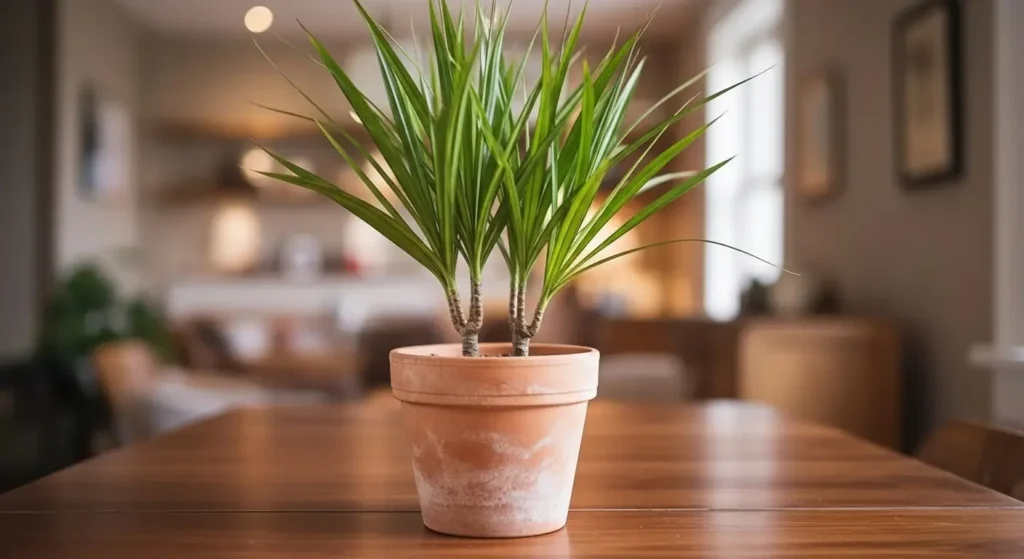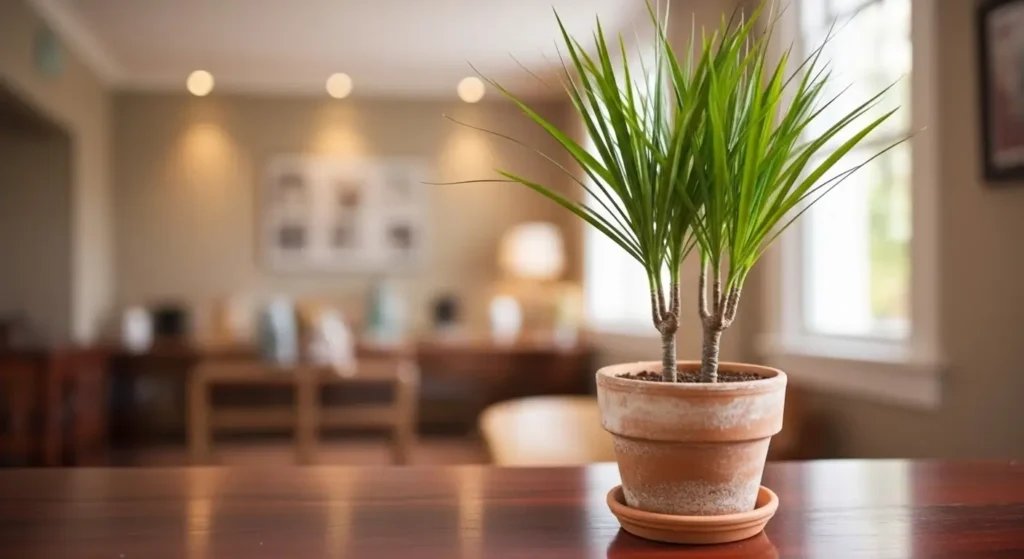
In This Article
The dracaena dragon plant, commonly known as the dragon tree (botanical name Dracaena marginata), is a stunning tropical houseplant famous for its architectural form. With its spiky, sword-shaped leaves featuring vibrant red or purple edges, this plant brings dramatic flair to any indoor space. Native to Madagascar and other subtropical regions, the dracaena dragon plant is one of the most forgiving indoor plants you’ll ever grow. It thrives with minimal fussing, making it perfect for beginners and busy plant lovers alike.
Plant Care Card
| Attribute | Details |
|---|---|
| Common Name | Dragon Tree, Dragon Plant, Madagascar Dragon Tree |
| Botanical Name | Dracaena marginata |
| Family | Asparagaceae |
| Plant Type | Tropical evergreen perennial |
| Mature Size | 6-10 feet tall indoors, 2-3 feet wide |
| Sun Exposure | Bright indirect light |
| Soil Type | Well-draining, loose potting mix |
| Soil pH | 6.0-6.5 (slightly acidic) |
| Hardiness Zones | 10-12 (USDA) |
| Native Area | Madagascar, tropical Africa |
| Toxicity | Toxic to cats and dogs |
Dracaena Dragon Plant Care
Honestly, caring for a dracaena dragon plant is easier than you’d think. This tropical beauty adapts well to typical household conditions and forgives the occasional care slip-up. In the following sections, we’ll cover everything you need to keep your dragon tree thriving for years to come.
Light
Your dracaena dragon plant loves bright, indirect light but tolerates lower light conditions surprisingly well. Place it near an east or west-facing window where it gets plenty of filtered sunlight. Too much direct sun will scorch those beautiful leaves, turning them yellow or brown. On the flip side, if your plant isn’t getting enough light, you’ll notice slower growth and the leaves losing their vibrant color.
A spot about 3-6 feet from a sunny window works perfectly. If you only have low-light areas available, don’t worry—your dragon tree will survive, just expect it to grow more slowly.
Soil
The key to happy roots is well-draining soil that doesn’t stay soggy. Your dracaena dragon plant needs a loose, airy potting mix that lets water flow through easily while still holding some moisture. A standard commercial houseplant mix works great, or you can make your own by combining equal parts peat moss, perlite, and potting soil.
Never use heavy garden soil alone, as it’ll compact in containers and suffocate the roots. According to Penn State Extension, incorporating materials like perlite or vermiculite improves drainage significantly, which is exactly what your dragon tree needs to prevent root rot.
Water
Here’s the thing: dracaena dragon plants prefer to dry out slightly between waterings rather than sitting in constantly moist soil. Water thoroughly when the top 2-3 inches of soil feel dry to your finger. During spring and summer, this usually means watering every 7-10 days. In fall and winter, cut back to every 2-3 weeks.
Overwatering is the number one killer of these plants, causing yellow leaves and root rot. Underwatering makes leaves droop and turn brown at the tips. If you’re unsure, it’s better to wait an extra day or two—these plants handle slight drought better than soggy feet.
Similar watering needs apply to spider plants, another forgiving houseplant perfect for beginners. Your dragon tree will also appreciate filtered or distilled water since it’s sensitive to fluoride and salts found in tap water.
Temperature and Humidity

Your dracaena dragon plant is perfectly happy at normal room temperatures between 65-80°F. It tolerates slightly cooler temps at night but keep it away from drafty windows, air conditioner vents, and heating units. Sudden temperature drops below 55°F can damage the plant.
As for humidity, these plants adapt to average household levels just fine. However, they’ll look their best with 40-50% humidity. If your home is particularly dry, especially in winter, lightly mist the leaves once or twice weekly or place the pot on a pebble-filled tray with water.
Fertilizer
Feed with balanced liquid fertilizer at half strength every 3-4 weeks during spring and summer. Stop fertilizing in fall and winter. For more guidance, check University of Maryland Extension’s fertilizer recommendations.
Types of Dracaena Dragon Plant
While Dracaena marginata is the classic dragon tree, several stunning varieties offer different looks for your plant collection:
- Dracaena marginata ‘Tricolor’: Features leaves with cream, green, and pink stripes along the red edges. This variety needs slightly brighter light to maintain its colorful variegation and grows to similar heights as the standard type.
- Dracaena marginata ‘Colorama’: Shows off bold magenta-red leaves with thin green stripes down the center. It’s more compact than other varieties, making it perfect for smaller spaces while delivering maximum visual impact.
- Dracaena marginata ‘Tarzan’: Sports wider, stockier leaves compared to the standard dragon tree. This variety creates a fuller, bushier appearance and is slightly more tolerant of lower light conditions.
- Dracaena fragrans ‘Massangeana’ (Corn Plant): Though not technically a marginata, this related dragon plant has wider leaves with yellow stripes down the center. It grows slower and tolerates even lower light than the Madagascar dragon tree.
Propagating Dracaena Dragon Plant

The best time to propagate your dracaena dragon plant is during spring and summer when it’s actively growing.
Propagating by Stem Cuttings
Stem cuttings are the easiest and most reliable method for creating new dragon trees. This technique works wonderfully even for beginners with no prior propagation experience.
Materials needed:
- Clean, sharp scissors or pruning shears
- Glass jar or vase filled with room temperature water
- Well-draining potting mix (for later transplanting)
- Small pot with drainage holes
Step-by-step instructions:
Step 1: Choose a healthy stem from your parent plant that’s at least 6-8 inches long. Make your cut just below a node (the bump where leaves attach) using clean, sharp scissors. Remove any leaves from the bottom 2-3 inches of the cutting.
Step 2: Place the cutting in a jar of room temperature water, making sure at least one node is submerged. Set the jar in bright, indirect light and change the water every 3-4 days to keep it fresh and prevent bacterial growth.
Step 3: Within 2-4 weeks, you’ll see white roots emerging from the nodes. Let the roots grow to about 2 inches long before transplanting. Once roots are established, you’ll also notice a new shoot appearing on the parent plant where you made the cut.
Step 4: Plant your rooted cutting in moist potting soil, keeping the soil consistently moist (but not waterlogged) for the first 2 weeks. After that, resume normal watering practices and watch your new dragon tree grow.
This same propagation method works beautifully for philodendron brasil, another easy-care trailing plant that roots readily in water.
Potting and Repotting Dracaena Dragon Plant
Dracaena dragon plants are slow growers, so they don’t need frequent repotting. Plan to repot every 2-3 years or when you notice roots growing through the drainage holes or circling the soil surface. Spring is the ideal time for this task.
Choose a new pot that’s only 1-2 inches larger in diameter than the current one. Going too big can lead to overwatering issues since excess soil stays wet longer. Make sure your new container has drainage holes this is absolutely critical for preventing root rot.
To repot, gently remove the plant from its old container and loosen the root ball slightly. Trim away any brown or mushy roots with clean scissors. Add fresh potting mix to the bottom of the new pot, position your plant at the same depth it was growing before, and fill in around the sides with more soil. Water thoroughly and let the excess drain away completely.
Common Pests and Diseases
Like most houseplants, your dracaena dragon plant can occasionally attract pests, especially if it’s stressed or the air is too dry.
Spider Mites
Fine webbing and tiny moving dots indicate these pests. They cause yellowing and stippling by sucking sap. Rinse leaves, increase humidity, or apply insecticidal soap weekly. According to University of California IPM, regular monitoring prevents serious infestations.
Mealybugs
Identify these pests by their white, cottony masses on stems and leaf undersides. They feed on plant sap and weaken your dragon tree over time. Remove them with a cotton swab dipped in rubbing alcohol or spray with insecticidal soap every 5-7 days.
Scale Insects
These hard, dome-shaped bumps attach firmly to stems and leaves. Scale insects are tricky because their protective covering shields them from many treatments. Scrape them off with your fingernail or a soft brush, then treat with horticultural oil or neem oil.
Aphids
These small, soft-bodied insects cluster on new growth and leaf undersides, sucking plant juices. They reproduce quickly but are easy to control. Spray them off with a strong stream of water or apply insecticidal soap every few days until they’re eliminated.
Common Problems with Dracaena Dragon Plant
Here’s how to troubleshoot common issues with your dracaena dragon plant:
Yellow Leaves
Yellow leaves can mean a few different things. Most commonly, it’s overwatering—check if your soil feels constantly soggy and cut back on watering frequency. Yellow leaves can also indicate natural aging (lower leaves yellow and drop as the plant matures, which is totally normal) or nutrient deficiency if you haven’t fertilized in months. Adjust your care routine and trim off yellow leaves once they’re completely yellow.
Just like with neon pothos, proper watering is the key to preventing yellowing leaves on your dragon tree.
Brown Leaf Tips
Brown, crispy leaf tips are usually caused by low humidity, fluoride in tap water, or underwatering. Increase humidity around your plant, switch to filtered or distilled water, and check that you’re watering deeply when the top soil dries out. Salt buildup from tap water or over-fertilizing can also cause this. Flush the soil occasionally with distilled water to remove excess salts.
Drooping or Wilting Leaves
Drooping leaves typically signal watering problems either too much or too little. Feel the soil: if it’s bone dry, give your plant a thorough drink. If it’s wet and the plant is still drooping, you’ve likely overwatered and may be dealing with root rot. Let the soil dry out completely before watering again and consider repotting if roots smell bad or look mushy.
Similar issues occur with peperomia plants when watering isn’t dialed in correctly.
Leggy Growth
If your dracaena dragon plant is growing tall and sparse with large gaps between leaves, it’s not getting enough light. Move it closer to a window or to a brighter location. You can also prune back leggy stems to encourage bushier, fuller growth from below the cut.
FAQ
How do you take care of a dracaena dragon plant?
Care for your dracaena dragon plant by providing bright indirect light, well-draining soil, and watering when the top few inches dry out. Keep temperatures between 65-80°F and fertilize monthly during growing season.
Is dracena a good indoor plant?
Yes, dracaena is an excellent indoor plant that tolerates low light, irregular watering, and typical household conditions. Its dramatic appearance and low-maintenance nature make it perfect for beginners and experienced plant parents alike.
Where is the best place to put a dragon plant?
Place your dragon plant near an east or west-facing window where it receives bright, indirect light. Avoid direct sun which burns leaves, and keep it away from cold drafts, heating vents, or air conditioner blasts.
How big do dracaena dragon trees get?
Indoor dracaena dragon trees typically grow 6-10 feet tall with a 2-3 foot spread, though growth is slow. With proper care indoors, they can live for decades and eventually reach ceiling height in some homes.
